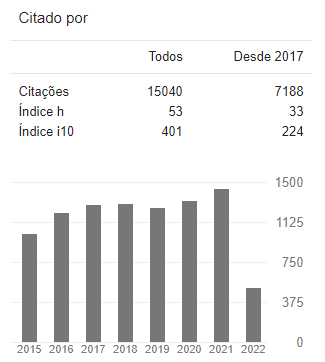Physical activity, sedentary time and bone tissue: effects of an 8-months interdisciplinary program with overweight/obese children
DOI:
https://doi.org/10.12820/rbafs.23e0053Palavras-chave:
atividade motora, estilo de vida sedentário, ossos, educação físicaResumo
A atividade física moderada-vigorosa tem efeito osteogênico reconhecido no osso. Além disso, o tempo sedentário e o acúmulo de gordura são desfavoráveis à saúde óssea. Este estudo objetivou: (1) examinar mudanças na composição corporal, tecido ósseo, atividade física e tempo sedentário; e (2) explorar se as mudanças nas intensidades de atividade física e no tempo sedentário estão associadas a mudanças nos resultados ósseos após um programa de intervenção interdisciplinar de base escolar. 53 estudantes com sobrepeso/obesidade (10,6 ± 3,5 anos; 26 meninas) participaram de aulas com atividade física. Área óssea, massa óssea e escore z de densidade mineral óssea, composição corporal (massa gorda, massa magra de gordura), atividade física, tempo sedentário e potenciais confundidores (vitamina D e status maturacional) foram avaliados no início e após 8 meses. Modelos Lineares Generalizados foram realizados e o nível de significância foi estabelecido em 5%. Alterações na atividade física moderada-vigorosa foram positivamente correlacionadas com as mudanças em todos os indicadores de massa óssea. Observou-se um efeito geral significativo da intervenção nas alterações do escore z de densidade mineral óssea, entretanto, após ajustes para mudanças no tempo sedentário e atividade física moderada-vigorosa, nenhum efeito foi observado. Por fim, variações no tempo sedentário e na atividade física moderada a vigorosa desempenham importante papel na densidade da massa óssea nos participantes do programa interdisciplinar.
Downloads
Referências
Trost SG, Blair SN, Khan KM. Physical inactivity remains the greatest public health problem of the 21st century: Evidence, improved methods and solutions using the ‘7 investments that work’ as a framework. Br J Sports Med. 2014;48(3):169–70.
Janz KF, Thomas DQ, Ford MA, Williams SM. Top 10 research questions related to physical activity and bone health in children and adolescents. Res Q Exerc Sport. 2015;86(1):5-12.
Gómez-Bruton A, Matute-Llorente Á, González-Agüero A, Casajús JA, Vicente-Rodríguez G. Plyometric exercise and bone health in children and adolescents: a systematic review. World J Pediatr. 2017;13(2):112-21.
Cadore EL, Brentano MA, Kruel LFM. Efeitos da atividade física na densidade mineral óssea e na remodelação do tecido ósseo. Rev Bras Med do Esporte. 2005;11(6):373-79.
Bass SL, Naughton G, Saxon L, Iuliano-Burns S, Daly R, Briganti EM, et al. Exercise and calcium combined results in a greater osteogenic effect than either factor alone: a blinded randomized placebo-controlled trial in boys. J Bone Miner Res. 2007;22(3):458-64.
Bucksch J, Sigmundova D, Hamrik Z, Troped PJ, Melkevik O, Ahluwalia N, et al. International trends in adolescent screen-time behaviors from 2002 to 2010. J Adolescent Health. 2016;58(4):417-25.
Lopes AS, Silva KS, Barbosa Filho VC, Bezerra J, Oliveira ES, Nahas MV. Trends in screen time on week and weekend days in a representative sample of Southern Brazil students. J Public Health. 2014;36(4):608-14.
Koedijk JB, van Rijswijk J, Oranje WA, van den Bergh JP, Bours SP, Savelberg HH, et al. Sedentary behaviour and bone health in children, adolescents and young adults: a systematic review. Osteoporos Int. 2017;28(9):2507-19.
Weiler HA, Janzen L, Green K, Grabowski J, Seshia MM, Yuen KC. Percent body fat and bone mass in healthy Canadian females 10 to 19 years of age. Bone. 2000;7(2):203-07.
Halade G V, El Jamali A, Williams PJ, Fajardo RJ, Fernandes G. Obesity-mediated inflammatory microenvironment stimulates osteoclastogenesis and bone loss in mice. Exp Gerontol. 2011;46(1):43-52.
Chaplais E, Naughton G, Greene D, Dutheil F, Pereira B, Thivel D, et al. Effects of interventions with a physical activity component on bone health in obese children and adolescents: a systematic review and meta-analysis. J Bone Miner Metab. 2018;36(1):12-30.
Aires L, Silva G, Martins C, Marques E, Lagoa MJ, Ribeiro JC, et al. Exercise intervention and cardiovascular risk factors in obese children. Comparison between obese youngsters taking part in a physical activity school-based programme with and without individualized diet counselling: the ACORDA project. Ann Hum Biol. 2016;43(3):183-90.
Cole TJ. Establishing a standard definition for child overweight and obesity worldwide: international survey. BMJ. 2000;320(7244):1240.
Tanner JM. Growth at Adolescence: With a General Consideration of the Effects of Hereditary and Environmental Factors Upon Growth and Maturation from Birth to Maturity. 1962.
Mota J, Guerra S, Leandro C, Pinto A, Ribeiro JC, Duarte JA. Association of maturation, sex, and body fat in cardiorespiratory fitness. Am J Hum Biol. 2002;14(6):707-12.
Fulkerson JA, Himes JH, French SA, Jensen S, Petit MA, Stewart C, et al. Bone outcomes and technical measurement issues of bone health among children and adolescents: considerations for nutrition and physical activity intervention trials. Osteoporos Int. 2004;15(12):929-41.
Choi L, Liu Z, Matthews CE, Buchowski MS. Validation of accelerometer wear and nonwear time classification algorithm. Med Sci Sports Exerc. 2011;43(2):357-64.
Evenson KR, Catellier DJ, Gill K, Ondrak KS, McMurray RG. Calibration of two objective measures of physical activity for children. J Sports Sci. 2008;26(14):1557-65.
Trost SG, Loprinzi PD, Moore R, Pfeiffer KA. Comparison of accelerometer cut points for predicting activity intensity in youth. Med Sci Sports Exerc. 2011;43(7):1360-68.
Bachrach LK, Sills IN. Bone densitometry in children and adolescents. Pediatrics. 2011;127(1):189-94.
Thiese MS. Observational and interventional study design types; an overview. Biochem Medica. 2014;24(2):199-210.
Vicente-Rodríguez G, Ortega FB, Rey-López JP, España-Romero V, Blay VA, Blay G, et al. Extracurricular physical activity participation modifies the association between high TV watching and low bone mass. Bone. 2009;45(5):925–30.
McKay HA, MacLean L, Petit M, MacKelvie-O’Brien K, Janssen P, Beck T, et al. ‘Bounce at the Bell’: A novel program of short bouts of exercise improves proximal femur bone mass in early pubertal children. Br J Sports Med. 2005;39(8):521–26.
Yu CCW, Sung RYT, So RCH, Lui K-C, Lau W, Lam PKW, et al. Effects of strength training on body composition and bone mineral content in children who are obese. J Strength Cond Res. 2005;19(3):667–72.
Gracia-Marco L, Vicente-Rodriguez G, Casajus JA, Molnar D, Castillo MJ, Moreno LA. Effect of fitness and physical activity on bone mass in adolescents: the HELENA Study. Eur J Appl Physiol. 2011;111(11):2671–80.
Daly RM, Ducher G, Hill B, Telford RM, Eser P, Naughton G, et al. Effects of a Specialist-Led, School Physical Education Program on Bone Mass, Structure, and Strength in Primary School Children: A 4-Year Cluster Randomized Controlled Trial. J Bone Miner Res. 2016;31(2):289–98.
Ivuškāns A, Mäestu J, Jürimäe T, Lätt E, Purge P, Saar M, et al. Sedentary time has a negative influence on bone mineral parameters in peripubertal boys: a 1-year prospective study 2015 J Bone Miner Metab. 2015;33(1):85-92.
Macdonald HM, Ashe MC, McKay HA. The link between physical activity and bone strength across the lifespan. Int J Clin Rheumtol. 2009;4(4):437–63.
Nasri R, Hassen Zrour S, Rebai H, Fadhel Najjar M, Neffeti F, Bergaoui N, et al. Grip Strength is a Predictor of Bone Mineral Density Among Adolescent Combat Sport Athletes. J Clin Densitom. 2013;16(1):92–7.
Cao JJ. Effects of obesity on bone metabolism. J Orthop Surg Res. 2011;6(1):30-6.










